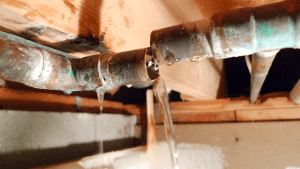Just how to Examine If Your House Has a Covert Leak
Just how to Examine If Your House Has a Covert Leak
Blog Article
This post below pertaining to Hacks to detect leaks is without a doubt compelling. You should look it over.

Early detection of dripping water lines can mitigate a potential disaster. Some small water leaks may not be noticeable.
1. Take A Look At the Water Meter
Every residence has a water meter. Examining it is a surefire way that helps you discover leaks. For starters, turn off all the water resources. Make sure no person will certainly purge, make use of the tap, shower, run the cleaning equipment or dish washer. From there, most likely to the meter and also watch if it will certainly alter. Considering that no person is utilizing it, there should be no movements. If it moves, that shows a fast-moving leakage. If you spot no modifications, wait an hour or two and examine back once more. This suggests you might have a slow-moving leakage that might also be underground.
2. Check Water Intake
If you spot abrupt modifications, despite your intake being the exact same, it suggests that you have leakages in your plumbing system. A sudden spike in your costs indicates a fast-moving leakage.
A consistent rise every month, even with the very same habits, reveals you have a slow leak that's also gradually escalating. Call a plumber to thoroughly examine your residential property, particularly if you really feel a warm area on your flooring with piping underneath.
3. Do a Food Coloring Test
When it comes to water usage, 30% comes from commodes. If the shade in some way infiltrates your bowl during that time without flushing, there's a leak in between the container and bowl.
4. Asses Exterior Lines
Don't forget to examine your exterior water lines as well. Must water leak out of the connection, you have a loose rubber gasket. One little leakage can lose heaps of water as well as surge your water bill.
5. Inspect as well as Evaluate the Situation
Homeowners need to make it a behavior to inspect under the sink counters and also inside cupboards for any bad odor or mold and mildew development. These 2 red flags indicate a leakage so timely attention is called for. Doing routine inspections, also bi-annually, can conserve you from a major trouble.
Inspect for stainings and deteriorating as most home appliances and pipes have a life expectations. If you suspect leaking water lines in your plumbing system, do not wait for it to rise.
Early detection of dripping water lines can reduce a prospective calamity. Some tiny water leaks might not be noticeable. Checking it is a surefire method that aids you uncover leaks. One small leakage can lose tons of water and also spike your water bill.
If you presume dripping water lines in your plumbing system, do not wait for it to rise.
WARNING SIGNS OF WATER LEAKAGE BEHIND THE WALL
PERSISTENT MUSTY ODORS
As water slowly drips from a leaky pipe inside the wall, flooring and sheetrock stay damp and develop an odor similar to wet cardboard. It generates a musty smell that can help you find hidden leaks.
MOLD IN UNUSUAL AREAS
Mold usually grows in wet areas like kitchens, baths and laundry rooms. If you spot the stuff on walls or baseboards in other rooms of the house, it’s a good indicator of undetected water leaks.
STAINS THAT GROW
When mold thrives around a leaky pipe, it sometimes takes hold on the inside surface of the affected wall. A growing stain on otherwise clean sheetrock is often your sign of a hidden plumbing problem.
PEELING OR BUBBLING WALLPAPER / PAINT
This clue is easy to miss in rooms that don’t get much use. When you see wallpaper separating along seams or paint bubbling or flaking off the wall, blame sheetrock that stays wet because of an undetected leak.
BUCKLED CEILINGS AND STAINED FLOORS
If ceilings or floors in bathrooms, kitchens or laundry areas develop structural problems, don’t rule out constant damp inside the walls. Wet sheetrock can affect adjacent framing, flooring and ceilings.
https://www.servicemasterbyzaba.com/blog/how-to-detect-water-leakage-in-walls/

Hopefully you enjoyed our section about Detecting hidden plumbing leaks. Thanks a lot for finding the time to browse our blog. If you please take the time to share this blog post if you enjoyed reading it. I am grateful for your time. Visit again soon.
Report this page